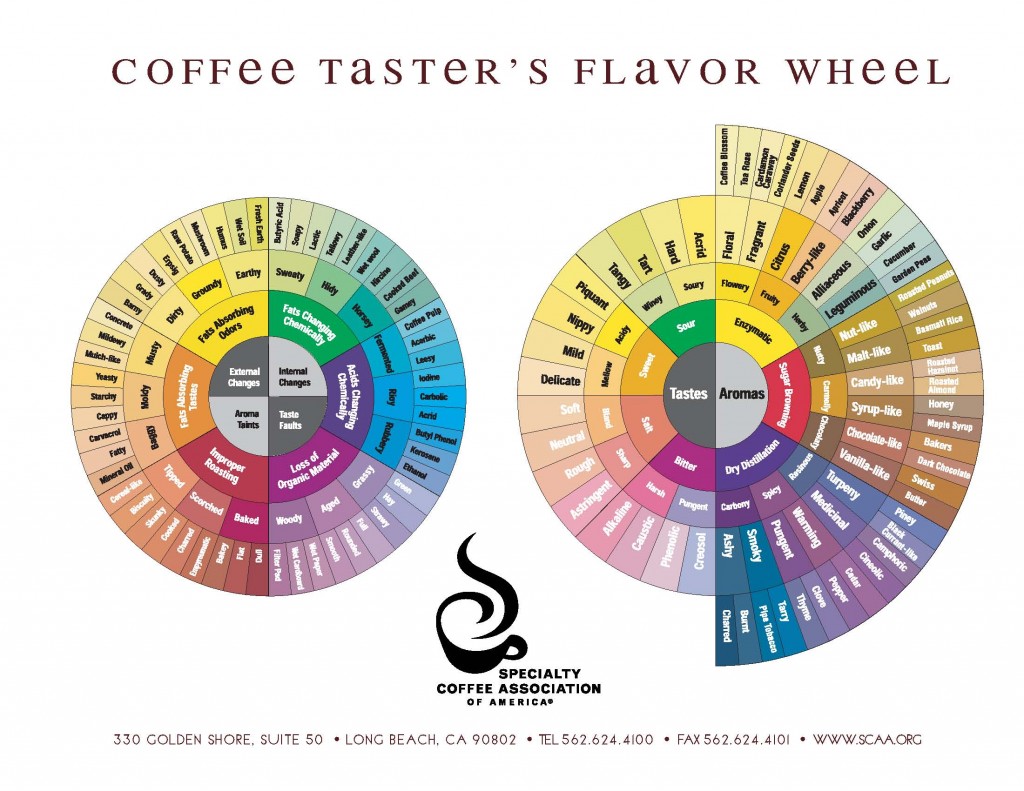How do you produce the strange smell of coffee?
In the process of brewing coffee, we all look forward to the moving moment full of fragrance:
Caramel, flowers, berries, nuts, honey, tea. Wait for all kinds of wonderful and complex aromas
It's definitely the most charming thing about coffee.

More than 300 aroma compounds can be detected in raw coffee beans and more than 850 in ripe coffee beans. (this data is quoted from boutique coffee science).
But in the process of baking or cooking, there will still be a bad strange smell, which is of course abhorrent.
It is necessary to select high-quality raw beans, filter defective beans and adjust appropriate cooking variables in order to keep the aroma beautiful and flash off the strange smell.
And understanding is the first step in preventing and finding a solution.
Therefore, the seniors shared a translation article explaining the causes of the strange smell of coffee for your reference.
Although it is not a very new article, but there is still a solid practical experience in the generation of strange smells (and written by celebrities)
You can still take a serious look, and compare the hands of Doudou, to find out the problem!
Another article is quoted from the blog of Kuka Coffee, but Kuka should not be the original translator, and the seniors can't find it. In order to be loyal to the original translator, all of the following contents remain unchanged. If some translations are not in line with your experience, please look at English for comparison.
The picture is made by the seniors themselves, so that everyone can imagine while looking at it.
Five stages that affect the aroma of coffee
This article is mainly translated from the third edition of "The Coffee Cuppers' Handbook" published by SCAA, Chapter 2
The corruption and defects of the fragrance. Author: Ted R. Lingle
The aroma of coffee is the main purpose for us to buy and drink coffee.
Perhaps some people drink coffee to enjoy the strong flavor of coffee, do not care about how much flavor, let alone how to cook the cup of coffee he chose.
The concentration of coffee feels to be the demand of these guests. Even so, we can't deny the emotion that most people feel when they enjoy the aroma of coffee.
Fragrance, only fragrance, is the highest value of coffee. Coffee lacks aroma, like a person without temperament. Temperament can have different forms and portions, and fragrance also has its different components and presentation.
Coffee that loses its flavor always makes people feel defective. Spend money on coffee, mainly because of its fragrance.
Through this article, we will look at the possible reasons why the coffee is stale or tasteless.
In the past, we have repeatedly mentioned that the factors affecting the quality of a cup of coffee come from four important stages, namely:
1. Coffee plantation management: including varieties, planting environment and climatic conditions, fertilization, irrigation, pest control, etc.
two。 Post-harvest treatment methods: including collection methods, post-harvest preservation, post-harvest treatment methods, cleanliness and hygiene of treatment sites, drying methods, storage methods and environment, and shelling process. And then there is the transportation process.
3. Baking method: including the understanding, operation and preservation of roasted coffee beans.
4. Make coffee.
In other words, in the above stages are shaping the quality of coffee, but also due to improper operation, so that the quality of coffee defects.
The following are the main points mentioned in the Coffee Cup Tester Handbook, which is about the timing of corruption and defects in the aroma of coffee beans, which is worthy of our coffee workers' reference:
The first stage takes place during harvest and drying.
When farmers dry the coffee fruit or coffee beans, it will affect the aroma of the coffee beans and, in serious cases, cause a rotten smell.
During the harvest of coffee fruit, if the fruit is left in the coffee garden for too long, the bad smell in the garden will continue to be produced, and the enzymes inside the fruit will begin to decompose the dough material of the seed.
Because of chemical changes, arabica coffee beans produce "Rioy" and robusta "rubbery".
In the drying stage, if the coffee fruit is placed in a high-temperature and humid environment, the action of internal enzymes is accelerated to produce "fermented flavor" (fermented).
(explanation: this is why it is repeatedly stressed that after the coffee fruit is harvested, the peeling work should be completed on the same day, or within 24 hours, and should not be stacked for too long.)
In general, coffee beans are laid on the cement floor, or on a high drying bed, or on plastic cloth.
The main purpose is to keep the sun-drying place clean and dry to avoid pollution. If the coffee beans are placed in a dry place, especially when the soil is dry, the oil inside the beans absorbs the smell of the soil and produces a "earthy".
If you put coffee beans in wet places, it is easy to cause mildew and produce a "moldy smell" (musty). If it is dried mechanically and the drying speed is too fast, the oil inside the beans will decompose, resulting in a "skin smell" (hidy).
(explanation: mildew seems to happen slowly. In fact, because the environment is humid or drenched with Rain Water, coffee beans get moldy very fast, about 1-2 days, you can see the appearance of moldy phenomenon. In fact, when you see the appearance of mildew, it has been moldy for some time.)
The second stage occurs in the storage stage, which is the aging stage of coffee beans.
This stage is from harvest and drying to the period of baking.
In the first few months after harvesting and processing, coffee beans have a unique grass smell, like the smell of freshly harvested alfalfa, known as "grassy".
The enzyme inside the raw bean continued to function, and after a few months, this aroma characteristic gradually decreased. Until it is shipped and sold, it is called "new crop", that is, "seasonal beans".
(explanation: fresh beans that have just been harvested and finished have their own characteristics as well as their unavoidable smell of green. This is also the reason why foreign beans are not in a hurry to ship after they are "collected and finished". Is to reduce the smell of green.)
When coffee beans are properly stored, the speed of enzyme action will be reduced.
About a year later, these chemical changes began to affect the various acids in the coffee beans. The taste senses this change, and this coffee bean is already a "past crop". If the enzyme action greatly reduces the content of various acids after several years of storage of raw beans, the coffee beans are called "old beans or aged beans" (aged).
In addition to the enzyme action, coffee beans slowly lose organic matter and gradually produce a hay-like "strawy".
A few years later, coffee beans continue to lose organic matter, resulting in an unacceptable "wood smell" (woody).
The third stage occurs during baking, which is mainly coking.
When the baking temperature reaches 400 ℉ (204 ℃), the sugar inside the coffee bean continuously changes chemically: it combines with the organic and inorganic substances inside the coffee bean to form brown caramel.
The sugar inside the raw beans, as the heat increases, will affect the aroma contents.
If the heat is not enough, so that the coking process is not sufficient, the roasted coffee beans will have the smell of grass. The aroma is like the green bean (green peas) in green vegetables, called "stinky green flavor" (green).
If the heating process is too slow, the roasted coffee beans taste insipid and smell tasteless, which is called "roasted flavor" (baked).
If the baking rate is too fast-the edges of the coffee beans are obviously charred-the chemical changes are not complete, forming a "tipped". If the heat is too high, the surface of the coffee beans will be scorched, resulting in a "scorched smell" (scorched).
In the fourth stage, after baking, the coffee beans will exhaust.
After the coffee beans have been roasted, they begin to exhaust. At this time, the coffee beans are the freshest and full of aroma substances, most of which are volatile mercaptan or sulfur compounds.
After the coffee beans are ground into powder, a large amount of aroma will be lost. As exhaust continues, more volatile organic substances, water-soluble aromatic mixtures with fibrous noodles, will be lost with the release of carbon dioxide. The loss of this aroma results in the "flat" of coffee beans.
Coffee beans continue to exhaust and volatile organic matter continues to be emitted, resulting in "tasteless beans" (vapid).
If water and oxygen enter the coffee beans, the quality will be even worse.
First of all, the oil inside the coffee beans will be oxidized. The coffee flavor that comes out of the shadow leaves a "insipid".
Then, continued exposure to oxygen and moisture will accelerate the oxidation of linoleic acid and triglyceride, resulting in an unpleasant taste, a condition known as "stale" (stale).
Finally, the oil inside the coffee beans interacts with oxygen and water to produce an unpleasant quality, called "oil stink" (rancid).
The fifth stage is after brewing.
After the coffee is brewed (still), the aroma of coffee changes faster than at other stages.
After brewing, the coffee begins with the most "fresh" (fresh), that is, the most abundant volatile organic compounds that make up the coffee aroma.
If the effervescent liquid in an unsealed container is continuously heated, the action of active molecules and the high temperature make the loss of gaseous matter faster.
The brewed coffee first loses its aroma and becomes "flat".
Continue to heat up to evaporate the volatile matter, making the coffee "vapid".
Prolonging the heating time will affect the preservation of organic matter in the coffee solution.
Long-bond organic matter breaks into short-bond substances, which will increase the acidic taste, which is called "sour astringent taste" (acerbic). It is proved that the coffee contains chloric acid.
Secondly, due to the evaporation of water, the salt concentration in the solution is relatively increased, forming a "saltwater flavor" (briny).
If you continue to heat the protein and turn the coffee liquid into a gel, there will be a "tar flavor" (tarry).
Finally, the concentration of alkali-containing substances in the coffee liquid increased, its bitter taste plus salt, showing a "salt" (brackish).
Reproduced at: TAIWAN VVCAFE
Important Notice :
前街咖啡 FrontStreet Coffee has moved to new addredd:
FrontStreet Coffee Address: 315,Donghua East Road,GuangZhou
Tel:020 38364473
- Prev

There are 10 kinds of people who often appear in CAFE, which one are you?
What about the 10 kinds of people who will appear in Cafe? "TEEPR interesting movies" released on YouTube funny interpretation of the 10 kinds of people you may meet in the cafe, and these 10 kinds of people also show "multi-function" in Cafe, regardless of books, in a daze, the cafe is really wonderful. 10 kinds of people you will see in the coffee shop: 1. Chat is right or wrong: that is, the most common chat 2.
- Next

The smallest coffee shop in Britain a telephone booth turned into a coffee shop
Earlier in the UK, Britain collected advice from the people on "invigorating telephone booths", but there is a small coffee shop in Birmingham that uses the method of "activating telephone booths". The coffee shop named "Jakes Coffee Box" is located in the old red telephone booth and may be the smallest coffee shop in Europe! Jake, the shopkeeper, not only showed his creativity, but also challenged the difficulty, because the shop
Related
- Why can American refills for free? The difference between Americano and American drip pot coffee
- Being chased out of the rain in front of Starbucks?! Store: Sheltering from rain under umbrellas poses a safety hazard
- The white moonlight has changed?! Lucky launches "Big Winter Pear American"
- Hand-brewed coffee three-stage method, high-sweet and universal brewing method to share! What does the high sweet water level of hand-brewed coffee mean?
- What is the difference between raw, refined and full espresso coffee? How to extract espresso and taste good?
- A complete list of coffee bean names and their meanings! What is Yejia Shefi coffee? Where is Mantelin coffee?
- What grade does Arida Manor Kaduai coffee beans belong to? What treatment is Arida ASD slow anaerobic sun exposure?
- The milk tea cup becomes smaller?! Overlord Tea Girl launches a new "Return to Yunnan" series
- Accused of selling counterfeit and high-priced coffee beans! Well-known boutique coffee brand "Oukelao" bowed and apologized!
- How to make espresso dumplings? Can I eat coffee and glutinous rice balls together?

